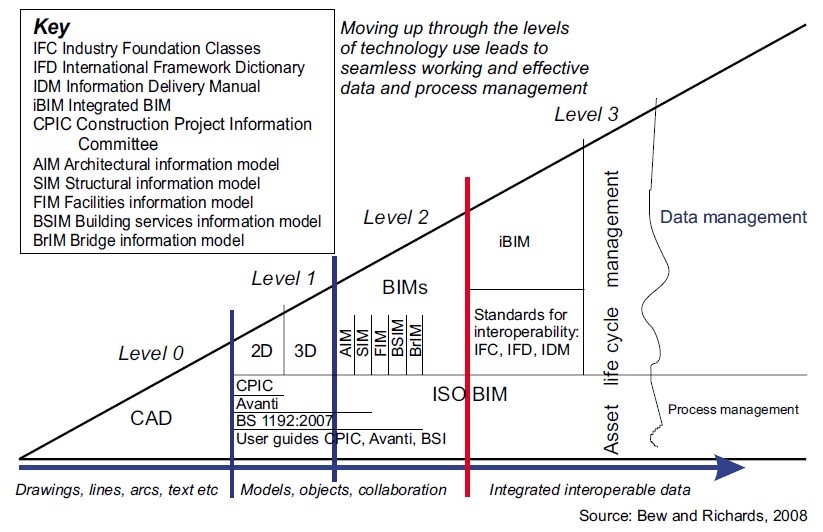BIM Standards: ISO 19605 and more. Different Levels of BIM Maturity Model.

As a relatively new technology, building information modeling (BIM) is bound to have a list of widely accepted standards sooner or later. BIM itself can be defined as a shared knowledge resource that hosts various information about a specific project, helping make appropriate decisions at all stages of the project.
BIM has been everyone’s hot topic for the last few years, and for good reason. The potential advantages of adopting a comprehensive BIM system are massive and far outweigh all potential disadvantages. Substantial differences can be noticed in efficiency, speed, collaboration, accuracy, and so on.
However, the spread of BIM is still quite limited for several reasons. There is a severe lack of understanding of how everything works, and the amount of investment needed to have all the advantages is still massive. It should also be noted that the lack of standardization is still one of the most significant factors stopping the spread of BIM: there is a large number of different software applications currently on the market, each with its standards and often without a proper way to share information with other solutions.
The existence of so many BIM applications makes it incredibly hard to pick the proper solution for yourself, and the number of proprietary formats is staggering. This is why BIM needs a specific set of standards to be popular and widespread. The existence of standards allows for the existence of several different levels of BIM, each with its own list of capabilities and advantages.
BIM standards and different levels of BIM
Multiple BIM standards already exist today, with ISO 19650 being one of the first international BIM standards to be introduced. The International Organization for Standardization creates these standards, and so far, at least two parts of it are included and working:
- Concepts and principles.
- Delivery phase and assets.
In general, ISO 19650 primarily refers to the organization and digitization of various information about civil engineering buildings, including BIM as one method of interacting with such information. The origins of ISO 19650 can be found in two British standards: BS 1192 and PAS 1192-1.
Both of these standards attempt to decrease overall construction costs. They provide a more effective framework to help different process participants collaborate, improving almost all stages of construction. Additional parts of ISO 19650 are also being developed. They should be focused on BIM security, asset management, the operational phase of the process in general, etc.
While there are several ways to approach the topic of BIM standards and levels, the fact that we started with the ISO formats makes it easier for us to showcase how the levels of BIM are qualified in the UK.
It should also be noted that while it is possible to use levels of BIM and BIM standards interchangeably in a specific context, several similar concepts are entirely different from BIM maturity levels, such as the level of development, level of detail, and level of information needed. None of these parameters are associated with BIM standards or levels, so it is vital to consider this distinction when proceeding.
Level 0 of the UK BIM standards
Generally speaking, three different levels of information of BIM are commonly known, and there is at least one more that is not as frequently used as the others. The standard in question is called BIM level 0, and it still exists technically, even though it means a complete lack of collaboration and a limitation to 2D CAD drawings. It is safe to say that the industry has been past this level for a while now.
Level 1 of the UK BIM standards
Currently, two levels of BIM standards are available in the context of ISO 19650. Level 1 is entirely defined by BS 1192 – Collaborative production of construction, engineering, and architectural information. Several requirements are included in this level:
- BS 7000-4 – Design management
- BS 8541-2 – Recommendations about 2D symbols to use with building elements
- ISO 12006-2 – Information classification in construction (framework)
- BS EN ISO 13567-1, 13567-2 – CAD overview, codes, and formats used in the construction documentation.
BIM level 1 is the first level of information of BIM. It works on integrating parts of BIM into the construction process, including CDEs, unified information hierarchy, spatial coordination, roles and responsibilities that are known by everyone, and so on. However, coordination between departments is kept to a minimum, so the advantages of seamless communication and data sharing are practically non-existent at this level.
Level 2 of the UK BIM standards
The next level of BIM standards in the UK is much more extensive and now includes 8 core standards simultaneously. Each standard may also include one or several other requirements, in one way or another, which describe the standard:
- PAS 1192-2. Data management specifications for the delivery and capital phases of the construction project in the context of BIM.
- PAS 1192-3. Data management specifications for the operational phase of the BIM project.
- BS 1192-4. Collaborative information creation and exchange.
- PAS 1192-5. Smart asset management, digital environments, and security-related BIM specifications.
- BIM protocol.
- dPoW (Digital Plan of Work).
- BS 8536-1. Everything about building infrastructure.
- Implementation of ISO 12006-2:2015 about classification.
BIM level 2 takes the collaboration aspect to the next level, promoting cooperation via streamlined information exchange and coordination between departments and providing each participant with their own 3D CAD model of the project. It is also the first BIM maturity level that uses open formats such as IFC to transfer information between different models. This level of BIM has been widely accepted as the bare minimum throughout the construction industry in the UK since 2016, and it is also popular in many other countries worldwide.
BIM maturity level 2 is also where the topics of advanced dimensions of BIM start to be mentioned more frequently. Not only does this concept support the use of BIM models for visualization (3D), but also beyond that, with concepts such as 4D (planning and scheduling) and 5D (resource management) being integrated into BIM maturity level 2 plans regularly.
As a brief reminder, we would like to mention that the concept of BIM dimensions is somewhat similar to the BIM maturity levels we discuss in this article, but with one key difference. BIM dimensions are less about evaluating the existing situation and more about improving existing capabilities using a combination of methods and practices in a single category of specialization.
Level 3 of the UK BIM standards
Standard-wise, level 3 is not as refined as the other two for now, but it is an ongoing process that continues to improve. The expected list of standards that will be included in this level is as follows:
- ISO 12006-3. Building construction.
- ISO 16739. Facility management.
- ISO 29481-1. Methodology and format of IDM.
- ISO 29481-2. Interaction with IDM.
- BS 8541-1, BS 8541-3, BS 8541-4, BS 8541-5, BS 8541-6, and more.
Often referred to as “open BIM” or “integrated BIM,” level 3 of BIM is supposed to enforce higher standards of cooperation and collaboration via unified information standards, shared project models, simultaneous work on the same model, and many more options.
This level is sometimes defined differently because it is not as widely accepted and used as level 2. At the same time, the expected advantages of transitioning from BIM level 2 to level 3 are still massive, including unprecedented collaboration capabilities, seamless information sharing, the complete integration of various IoT devices into the infrastructure, and more.
The highest of the existing BIM maturity levels is also the only one which supports some of the highest dimensions of BIM so far, including 6D (sustainability and green construction) and 7D (integrated facility management).
However, adopting BIM level 3 at the same scale and speed as happened with level 2 has proven to be far more complex, even in the example of a single country (such as the UK). The difficulty of implementation and the upfront cost of all the changes and modifications are much higher this time around, so many construction companies are not particularly keen on hurrying to adopt BIM level 3.
As such, the United Kingdom’s Digital Built Britain strategy defines four different levels of adoption instead of introducing BIM level 3 as mandatory in all construction projects. These four levels are:
- 3A – Making improvements to the existing level 2 model.
- 3B – Adopting newer systems and technologies.
- 3C – Developing fresh business models with a different outlook on the entire industry.
- 3D – Building upon the authority BIM has in the global sphere.
All four of these levels exist to create a solid foundation for the upcoming transition to level 3. Still, the government is not trying to rush too much in this regard, mainly because the UK has already been at the forefront of government-mandated adoption of BIM for years now.
BIM Level 4 and beyond
The concept of BIM evolves and improves regularly, with new capabilities and standards appearing relatively frequently. The topic of BIM maturity levels is no different. For example, BIM maturity level 4 was introduced recently, with a significant focus on health, safety, and social outcomes.
BIM level 4 is supposed to be the most advanced level of BIM maturity. It features generative design, advanced data analytics, automated construction analysis, and other high-tech capabilities to optimize the entire building lifecycle from start to finish.
However, this concept is still far too young and fresh to be of any value or significance at scale, so information about it is still minimal.
Measurement of BIM maturity levels
Like any other highly specialized evaluation process, performing a BIM maturity assessment can be challenging for multiple reasons. One of the biggest problems is the potential for bias, even if it is unintentional, which can skew the results of the evaluation and lead to the setting of incorrect company goals.
There are several methods of evaluating yourself outside of blindly assuming your current situation. The BIM Maturity Matrix from the BIMe Initiative (BIM Excellence) is a valuable tool for identifying the current maturity of the BIM model in an organization by performing a thorough assessment of different parameters.
The BIM Maturity Matrix uses two axes in its structure: the BIM Maturity Index and BIM Capability.
The former is a numerical representation of the current capability to improve the quality of the organization’s processes. The latter is the bare minimum of BIM capabilities that the company should be able to provide based on its capabilities and opportunities.
The entire Maturity Matrix includes an evaluation template and instructions on using it. We highly recommend looking into it if you want to perform a BIM maturity assessment for your organization.
Most significant challenges of measuring and improving BIM maturity levels
The overall evaluation process can be somewhat subjective, but there is another significant problem that BIM maturity measurement regularly encounters. The issue comes from the industry’s fragmented nature, which still plagues most construction projects.
The reality of the construction industry is that many construction projects are performed in multiple steps, each operated and coordinated by a separate team or organization. This leads to the adoption of different BIM standards and rules for every new project phase from start to finish while also fragmenting the results of any evaluation.
In these scenarios, even if a single general contractor implements many different BIM capabilities (such as 4D and 5D BIM, for example), the lack of coordination with other project teams will still mark it as BIM maturity level 1 at best.
The situation described above is so common that it even has its own name: “little BIM” or “lonely BIM.” This represents an implementation of BIM that is not supported or coordinated with other project participants for some reason, making it significantly less effective than initially intended. In this context, it would be wise to remind everyone about the fact that the UK’s BIM maturity levels are not the only way to evaluate the BIM capabilities of a company, and it is also not a definitive score due to the large number of moving parts involved in each BIM implementation framework.
Diagram of levels of BIM
All of these different levels of BIM (sometimes described as “levels of BIM maturity” or the “UK BIM maturity model”) can be visualized in the form of a diagram of levels of BIM. Due to its shape, this kind of diagram is often referred to as a “wedge.” It is used as a critical component in the national BIM policy within the UK.
At the same time, the relative simplicity of this diagram of levels of BIM allows it to serve as an excellent example of the different levels of BIM and what they are supposed to do. Some variations of the model might include the bare minimum of the intended level of BIM integration, and others might also describe the different standards and processes involved.
This model was initially developed in 2008 by Mervyn Richards and Mark Bew. Below is one example of such a model.

Conclusion
The potential of BIM is genuinely massive, and it is possible to improve almost every aspect of the construction process of various projects in engineering, architecture, and more. However, it is also essential to have a set-in-stone standard that everyone can rely on to avoid problems with importing file formats, exporting data to different software applications, etc. This is why BIM standards are so important now, and the ongoing trend of integrating BIM in many industries is making this transition even faster.
Frequently Asked Questions
How can I determine my company’s level of BIM maturity?
While it is possible to assume your current level of BIM maturity based on personal knowledge about the company, it is highly recommended that you use one of the existing methods with detailed evaluation processes, such as the BIM Maturity Matrix provided by the BIM Excellence project. It shows a complex table that allows for each specific capability of a company to be evaluated based on BIMe’s BIM Maturity Index.
What is the purpose of the ISO19650 standard in the context of BIM?
ISO 19650 is an international framework for information management throughout the BIM project lifecycle. Its efforts mainly focus on improving general project efficiency and standardizing various BIM processes to facilitate their adoption.
How many different standards are there for BIM evaluation?
Aside from the UK BIM levels discussed in this article, there are at least several approaches to the same goal. Although it would be fair to say that all of them represent different goals, the “BIM dimensions” evaluation focuses on a completely different idea, using specific features and categories instead of a company’s general capability to perform a number of different tasks.




